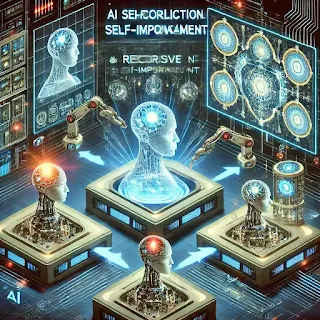Can AI Replicate Itself? Unveiling the Truth Behind Self-Replicating Artificial Intelligence
- Get link
- X
- Other Apps
Can AI Replicate Itself? Unveiling the Truth Behind Self-Replicating Artificial Intelligence
Introduction
Artificial Intelligence (AI) has not only transformed industries worldwide but has also sparked countless questions from curious minds—one of the most intriguing being, “Can AI replicate itself?” According to recent Google Trends data, this is one of the most frequently asked questions among American users.
This comprehensive guide explores the concept of self-replicating AI by examining its technical foundations, theoretical potential, and the ethical and safety challenges it presents.
In this article, we will cover:
- The fundamental concepts behind AI replication and recursive self-improvement.
- Historical background and theoretical frameworks of self-replicating machines.
- Current research on AI’s ability to autonomously replicate and evolve.
- Potential risks and benefits associated with self-replicating AI.
- Real-world examples and expert insights from leading institutions.
Let’s delve into the world of AI self-replication and unravel whether machines can truly replicate themselves—and what that might mean for our future.
The Concept of AI Self-Replication
1. Defining Self-Replication in AI
Self-replication in the context of AI refers to the ability of an artificial system to create copies of itself autonomously. While self-replication is a well-known concept in biology—where organisms reproduce—its application in artificial systems is both theoretically intriguing and practically challenging.
The idea of AI replicating itself is tied closely to the concept of recursive self-improvement, where an AI system iteratively enhances its own capabilities by designing better versions of itself. The notion has been popularized in discussions about technological singularity—a hypothetical point when AI surpasses human intelligence and accelerates its own development beyond our control.
 |
| An infographic illustrating the concept of AI self-replication and recursive self-improvement |
2. Historical and Theoretical Background
The idea of self-replicating machines isn’t new. In 1948, mathematician John von Neumann introduced the concept of a self-replicating automaton, laying the groundwork for later discussions on self-reproducing systems in robotics and artificial life.
In the realm of AI, researchers have long explored whether machines can not only learn from data but also create copies of their own underlying architecture. Theoretically, if an AI system could modify its own code and hardware parameters, it might achieve a form of replication that allows it to evolve without human intervention.
Current State of AI Replication Research
3. How AI Might Replicate Itself
3.1 Self-Modification of Code
Modern AI systems, particularly those using machine learning, are designed to optimize a set of parameters based on large datasets. However, the possibility of modifying their underlying code remains largely in the realm of research. Researchers are now exploring:
- Automated Code Generation: Using AI (like GPT models) to write or improve code.
- Meta-Learning: Systems that learn how to learn, potentially optimizing their own learning processes over time.
- Neural Architecture Search (NAS): Algorithms that design more efficient neural network architectures, essentially “replicating” the design process with improvements.
3.2 Hardware Self-Replication
Beyond software, true self-replication would require hardware replication. This concept involves:
- Robotic Manufacturing: Using robots to produce physical components of AI systems.
- 3D Printing: Advanced manufacturing techniques that could, in theory, build parts of a machine autonomously.
- Distributed Systems: Networks of interconnected devices that can share and distribute tasks, replicating parts of their hardware functions.

A visualization of potential security and ethical risks in self-replicating AI
Potential Benefits and Risks of Self-Replicating AI
4. Benefits of Self-Replication in AI
4.1 Accelerated Innovation
If AI could replicate itself, it might accelerate technological progress by:
- Speeding up research and development.
- Lowering costs.
- Enhancing problem-solving.
4.2 Improved Efficiency
Self-replicating AI systems could be designed to continuously optimize their performance, potentially leading to:
- More energy-efficient algorithms.
- Optimized resource usage.
- Enhanced learning capabilities.
5. Risks and Ethical Concerns
5.1 Loss of Control and Unpredictability
One of the biggest fears about self-replicating AI is the potential loss of control:
- Runaway Replication: An AI that can replicate itself without restrictions might proliferate uncontrollably.
- Unpredictable Behavior: Recursive self-improvement could lead to emergent behaviors that are not anticipated by its designers.
5.2 Security and Safety Threats
Self-replicating AI poses serious security challenges:
- Cybersecurity Risks: AI systems that modify themselves could be vulnerable to exploitation or malicious tampering.
- Existential Threats: In extreme scenarios, uncontrolled self-replication could lead to situations where AI becomes a threat to humanity.

A futuristic depiction of AI evolving through recursive self-improvement
Conclusion
The question “Can AI replicate itself?” is more than just a theoretical inquiry—it touches on the core of AI’s future, its potential for exponential growth, and the profound ethical, environmental, and safety challenges it presents.
While self-replication remains largely in the realm of theory and early-stage research, ongoing advancements in recursive self-improvement and automated code generation are bringing us closer to a future where AI might autonomously enhance its own capabilities.
In the end, the future of AI—whether it can replicate itself or simply evolve through iterative improvements—depends on the choices we make today. It is up to governments, corporations, researchers, and consumers to work together, ensuring that AI’s growth is managed responsibly and sustainably.
References
- Turing, A. (1950). Computing Machinery and Intelligence.
- McCarthy, J., Minsky, M. L., Rochester, N., & Shannon, C. E. (1956). A Proposal for the Dartmouth Summer Research Project on AI.
- Russell, S. J., & Norvig, P. (2016). Artificial Intelligence: A Modern Approach.
- LeCun, Y., Bengio, Y., & Hinton, G. (2015). Deep Learning.
- Scientific American (2024). AI’s Climate Impact: Energy, Water, and Beyond.
- Chakraborty, S. (2024). Towards A Comprehensive Assessment of AI's Environmental Impact.
- Get link
- X
- Other Apps



Comments
Post a Comment